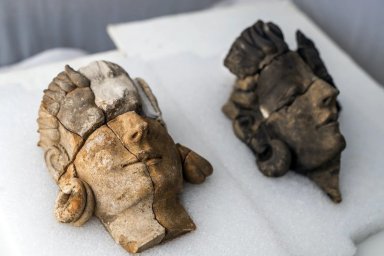Archaeologists uncover the first human representations of the ancient Tartessos people
Great find in Turuñuelo: the first five human faces of the Tartessian culture
Two carvings probably depict goddesses wearing gold earrings
Archaeologists excavating at the site of Casas del Turuñuelo have uncovered the first human representations of the ancient Tartessos people.
The Tartessos culture emerged during the Late Bronze Age in the Southwest Iberian Peninsula of Spain. The culture is characterised as having a mixture of local Paleo-Hispanic and Phoenician traits, while speaking a now extinct language called Tartessian.
The Tartessos people were skilled in metallurgy and metal working, creating ornate objects and decorative items. Characteristic Tartessian bronzes include pear-shaped jugs, shallow dish-shaped braziers with loop handles, incense-burners with floral motifs, fibulas and belt buckles.
They are believed to have worshiped the goddess Astarte or Potnia, and the masculine divinity Baal or Melkar. This was due to acculturation by their Phoenician trading partners.
A press release issued by the Higher Council for Scientific Research (CSIC) has announced the discovery of figured reliefs depicting human representations during excavations at Casas del Turuñuelo, a Tartessian site in the Province of Badajoz.
The reliefs date from around the 5th century BC and were discovered in the remains of a sanctuary used for the ritual sacrifice of animals. The sanctuary was discovered back in 2017, where archaeologists from the Archaeology Institute of Merida uncovered the remains of 16 horses, 2 bulls, and a pig.
Two of the reliefs appear to be female figures, which the researchers suggest could be representations from the Tartessian pantheon of gods. The three other reliefs are fragmented and in a poorer state of preservation, however, one of them has been identified as a Tartessian warrior.
A spokesman from the CSIC said: “This extraordinary finding represents a profound paradigm shift in the interpretation of the Tartessos people, who are traditionally considered an aniconic culture for representing divinity through animal or plant motifs, or through betilos (sacred stones).”
2,600-year-old stone busts of ‘lost’ ancient Tartessos people were discovered in a sealed pit
Archaeologists in Spain have unearthed five life-size busts of human figures that could be the first-known human depictions of the Tartessos, a people who formed an ancient civilization that disappeared more than 2,500 years ago.
The carved stone faces, which archaeologists date to the 5th century B.C., were found hidden inside a sealed pit in an adobe temple at Casas del Turuñuelo, an ancient Tartessian site in southern Spain.
The pieces were scattered amongst animal bones, mostly from horses, that likely came from a mass sacrifice, according to a translated statement published on April 18.
“The unusual thing about the new finding is that the representations correspond to human faces,” Erika López, a spokesperson for the Spanish National Research Council (CSIC), said in the statement.
Archaeologists from the CSIC called this discovery “a profound paradigm shift in the interpretation of [Tartessos],” since this ancient civilization, which existed from about the eighth to the fourth centuries B.C., was long considered an aniconic culture in which divinity was represented through animal or plant motifs, rather than idolized humans, according to the statement.
Of the figurative reliefs, two are nearly complete and likely portray female divinities wearing earrings, which could be a nod to the Bronze Aged people’s adept goldsmithing skills.
Archaeologists found only fragments of the other three reliefs, but identified one as a warrior wearing a helmet, according to the statement.
Although the Tartessos didn’t leave much of an archeological record, archaeologists do know that they were skilled at goldsmithing; for instance, gold pieces similar to the reliefs’ earrings have been unearthed at two nearby Tartessian sites, Cancho Roano, and La Mata.
These locations were torched to the ground in a similar manner to the newly discovered pit site, but why and how these conflagrations occurred remains a mystery, according to an April 21 Vice article.
Some historians, including the Greek philosopher Aristotle, once linked the Tartessos people to the mythical lost city of Atlantis. However this idea “has been widely dismissed in the scientific community,” according to a 2022 BBC article.
“The finding only further influences both the importance of the site and the importance of the Tartessian culture in the Guadiana valley during its last moments,” López said in the translated statement.
The faces of Tartessos, the historic discovery
The five figures that appeared at the Turuñuelo site changed history
A unique and exceptional find. A milestone for the researchers of the Casas del Turuñuelo site, but also for the history of art and for the study of the Tartessian civilization that dominated the Mediterranean in the 5th century BC. C. The Institute of Archeology of Mérida surprised again this year with the presentation of what would be the first faces of Tartessos, the first human representations attributable to the first civilization of the West, halfway between the Bronze Age and the Iron Age, between the 12th and 5th centuries BC. c.
«It is the first time that we put a face on it, even if it is an idealized face. But more important than that is that it is the first time we see the hoop earrings (a type of earrings) or the diadems they were wearing," were the words before the press of Esther Rodríguez, the co-director of this investigation at the Casas del Turuñuelo site. (Guareña, province of Badajoz).
What was found were the fragments of five heads that belong to what is believed to be a relief that tells a story. Two of the faces represent women.
The discovery took place in April and the news spread around the world. Turuñuelo will continue to bring joy in 2024.
